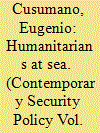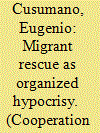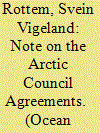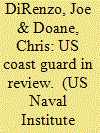|
|
|
Sort Order |
|
|
|
Items / Page
|
|
|
|
|
|
|
| Srl | Item |
| 1 |
ID:
150405


|
|
|
| 2 |
ID:
166613


|
|
|
|
|
| Summary/Abstract |
Between 2014 and 2017, no less than 10 different non-governmental organizations (NGOs) conducted maritime Search and Rescue (SAR) operations off the coast of Libya. By rescuing over 100,000 migrants in three years, these NGOs became the largest provider of SAR in the Mediterranean. The theory of institutionalism suggests that organizations conducting similar activities are likely to converge in a process of mimetic isomorphism, deliberately imitating one another to increase their effectiveness and cope with uncertainty. These 10 SAR NGOs, however, developed two different rescue models: While some rescued migrants and disembarked them in Italian ports, others only simply assisted those in distress until the arrival of another ship transporting them to land. They also cooperated with Italian and European authorities to different degrees. Why did SAR NGOs imitated many elements of existing non-governmental rescue models, but discarded some others? This article argues that differences in material capabilities and organizational role conceptions are crucial to explain why newer SAR NGOs have imitated most but not all of their predecessors’ policies, engaging in a process of “selective emulation.”
|
|
|
|
|
|
|
|
|
|
|
|
|
|
|
|
| 3 |
ID:
159091


|
|
|
|
|
| Summary/Abstract |
The existing international search-and-rescue system, with its shared responsibilities between
shipmasters and coastal states, is challenged by mass migration by sea, SAR cases that impinge on
national boundaries, and persons in distress who decline to be assisted.
|
|
|
|
|
|
|
|
|
|
|
|
|
|
|
|
| 4 |
ID:
097694


|
|
|
|
|
| Publication |
2009.
|
| Summary/Abstract |
Ships and those who sail in them face many potential dangers, both from the natural
perils of the sea and from the results of human conduct, which demand a precautionary
response from seafaring nations. The promotion of maritime security in Africa depends
on an international legal framework that provides both opportunities and constraints.
Traditional principles of the law of the sea are not always appropriate to current needs,
but they have been supplemented by more specific measures dealing with maritime
search and rescue, weapons proliferation, piracy and terrorism against ships. Although
good laws are a necessary pre-condition for the achievement of maritime security, they
will only be effective if there is also the political will and the practical capacity among
states to implement them. While much remains to be done, recent developments in
Africa provide some positive grounds for encouragement.
|
|
|
|
|
|
|
|
|
|
|
|
|
|
|
|
| 5 |
ID:
163494


|
|
|
|
|
| Summary/Abstract |
In November 2014, Frontex started its Southern Mediterranean border monitoring operation Triton, followed in June 2015 by the Common Security and Defence Policy anti-smuggling mission EU Naval Force Mediterranean (EUNAVFOR Med) ‘Sophia’. Both operations’ outward communication has placed considerable emphasis on the conduct of maritime search and rescue. Still, this commitment was not matched by consistent action. Triton and EUNAVFOR Med have conducted a relatively limited number of search and rescue operations, prioritizing border control and anti-smuggling tasks. This article explains the gap between the European Union missions’ humanitarian rhetoric and an operational conduct primarily focusing on curbing irregular migration as a form of organized hypocrisy. Decoupling talk and action allowed Triton and EUNAVFOR Med to reconcile the conflicting expectations arising from European governments’ willingness to reduce migrant arrivals and the normative imperative to act against the loss of life at sea. However, the European Union missions’ organized hypocrisy had several negative externalities, hindering effective management of the humanitarian crisis offshore Libya.
|
|
|
|
|
|
|
|
|
|
|
|
|
|
|
|
| 6 |
ID:
137397


|
|
|
|
|
| Summary/Abstract |
In 2011, the member states of the Arctic Council signed the Arctic Search and Rescue Agreement, the first legally binding agreement negotiated under the auspices of the Arctic Council. In 2013, an Agreement on Oil Spill Preparedness and Response was signed. The purpose of this article is to explore why the two agreements have been negotiated, examine their substance, and assess their practical impact. Norway is used as an illustrative case. It is argued that both agreements are more important for the Arctic Council than for Norway. Explaining the reality of the agreements can indicate something about the potential for future agreements negotiated under the auspices of the Arctic Council.
|
|
|
|
|
|
|
|
|
|
|
|
|
|
|
|
| 7 |
ID:
124672


|
|
|
|
|
| Publication |
2013.
|
| Summary/Abstract |
Over the years the naval air arm has grown from a modest force to a full-fledged operational arm with an inventory of more than 200 aircraft. These include fighters, helicopters, maritime reconnaissance aircraft and Unmanned Aerial Vehicles (UAVs) with the capability to support the entire spectrum of maritime operations covering all dimensions of naval warfare. The navy's air arm operates from aircraft carriers, ships and a large number of naval airfields located across the Indian Littorals.
In May this year, naval aviation marked its 60 years of existence with the commissioning of its Air Squadron (Black Panthers) equipped with MiG 29K fighter jets for Carrier borne operations. This was followed by the induction of Boeing P-81 Poseidon MR-ASW aircraft and finally, in a historic development with far-reaching operational consequences, the Indian Navy took delivery of INS Vikramaditya. The acquisition of this 44,570 tonne carrier marks a new phase in India's quest to become a true blue water navy and is likely to have generated more than a passing interest within the People's Liberation Army Navy (PLA Navy) and across the rest of the Continent. These developments will place the Indian Navy at par with Russian and US navies as far as hardware is concerned.
In the fighter jet category for operating out of aircraft carriers, the naval aviation has two squadrons of the Sea Harrier which operate from INS Viraat. These were acquired by the Indian Navy in the mid Eighties and these jets had also operated ex INS Vikrant. Action was initiated to get additional Sea Harrier jets from Britain when the same were decommissioned by the Royal Navy, but the proposal did not fructify due to technical glitches. The proposal for a mid-life upgrade in the late Nineties was cancelled when the decision was taken to purchase MiG-29K jet fighters to be deployed aboard the INS Vikramaditya.
As the Harriers are expected to remain in service with the navy till 2015, limited upgrades are being done by Hindustan Aeronautics Limited (HAL). The indigenously produced Kiran (jet fighter trainer), which is currently being used for training, is likely to be phased out following the induction AJT Hawk jet trainers. The Kirans have been part of the elite Naval Aerobatic Display Team, 'The Sagar Pawans'.
In the Long Range Maritime Reconnaissance stream, the navy presently operates eight Tupolev Tu-142 aircraft which entered service in 1988. Upgrade of the aircraft is in process to extend its service life. These aircraft operate from INS Rajali and INS Hansa. In the Medium Range category, the navy has the Islander aircraft inducted into the navy in 1976 - these aircraft are vintage and need immediate replacement. In the Short Range category, the navy operates the HAL-built Dornier aircraft which continues to meet the surveillance and reconnaissance requirements of the navy.
Helicopters form a key element of a naval fleet at sea due to its ability to easily operate from frigate size ships and carry out diverse roles from anti-submarine warfare (ASW) to electronic warfare (EW), airborne early warning (AEW) and search and rescue (SAR). The Indian Navy operates a helicopter fleet consisting of the Sea King (ASW), Kamov 28 and 31 (ASW) and the modified Chetak-MATCH (Mid Air Torpedo Carrying Helicopter). In addition, they have a fleet of Chetak helicopters for shipborne operations. These helicopters are old and need replacement/upgrades. The HAL manufactured Dhruv (naval variant) was inducted into the air arm in March 2002. However, the navy found the Dhruv unsuitable for its role as an ASW platform. The Kamov-31 AEW helicopters acquired from Russia in the Nineties has proved to be a versatile platform for airborne operations at sea; more numbers are likely to be inducted.
|
|
|
|
|
|
|
|
|
|
|
|
|
|
|
|
| 8 |
ID:
124012


|
|
|
|
|
| Publication |
2012.
|
| Summary/Abstract |
In 2011 the U.S. Coast Guard continued its mission by responding to devastating hurricanes, floods, and droughts; interdicting maritime threats to our nation; supporting defense operations around the world; and seeking solutions to its expanding responsibilities in the Arctic.
|
|
|
|
|
|
|
|
|
|
|
|
|
|
|
|
|
|
|
|
|